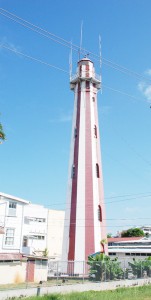A local construction engineer has expressed concern over whether the foundation of the 103 ft, 178-year-old Kingston Lighthouse could withstand the heavy pile driving that would be required for the building of a hotel.

A site in the area has been earmarked for the construction of a US$52 million 160-room hotel with casino, nightclub, restaurants and a conference centre in a ten-storey building of approximately 185,000 square feet. Preparatory work, such as clearing the site of derelict buildings and vegetation, has been completed and the developers are currently seeking an environmental permit to begin work this year.
The engineer, who prefers anonymity, told Stabroek News that he was concerned about the weakening of the foundation of the lighthouse, buildings in the vicinity and the seawall itself due to the pile driving exercise that would be necessary.
There was also a suggestion that instead of building a hotel, the history of the area should be preserved through the recreation of the historical Fort Groyne.
The lighthouse, with its distinct vertical red and white stripes, was first built as a wooden structure by the Dutch in 1817 and then replaced by British engineers with a brick structure in 1830 (it was commissioned on June 1, 1830). The current building, which is a national monument, was reinforced on a foundation of 49 greenheart piles.
The lighthouse, as an aid to navigation is covered under the Guyana Shipping Act 1998. It says, under Section 242, that no aid shall be established without the prior authorisation of the director and unless it confirms to such specifications as may be stipulated; no aid shall be discontinued or have its fighting characteristics or any other distinguishing feature altered. The Act also stipulates that the director shall ensure that all aids are established in compliance with the stipulated conditions and specifications and are maintained in working order; and bring to the attention of the public information on changes to, or, deficiencies in any aid to navigation.
Meanwhile, historical architect and member of the National Trust, Lennox Hernandes, said he believed the area was bad for hotel development.
“I personally feel it is bad for hotel development from a historical architectural point of view,” he said, adding, “Fort Groyne is a very historical area. There is a lot of history there. Building a hotel on that site would be taking away the history from the people. I think history should be recreated to benefit all Guyanese.”
Recreating the historical site, he said could enhance tourism and recreation development in the area and it may have economic benefits though not the same as a hotel.
He bemoaned the fact that the Luckoo Swimming Pool was not reconstructed and suggested that it could still be rebuilt to add to the limited recreational facilities, badly needed in the city. Building a hotel there, he added would be “taking that recreation facility out of the hands of ordinary Guyanese.”
Meanwhile, Environmen-tal Management Consultants (EMC), which conducted an Environmental Social Impact Assessment (ESIA) for the developers of the hotel Adam Development/Urbahn Associates (ADUA) has suggested placing a beacon on the highest point of the hotel with further range, greater visibility and low maintenance. The recommendation was made to mitigate the hotel project standing in the way of the Lighthouse, which serves as the beacon to incoming ocean-going vessels, at the mouth of the Demerara River.
Stabroek News understands that the Marine Administration Department (MARAD) is looking at options as to where to place the light to guide mariners at sea who depend on the Lighthouse, in the event that the hotel is built.
In a telephone interview, Harbour Master Volton Skeete told Stabroek News on Friday that the proposed hotel would be a larger building that would block the Lighthouse from mariners at sea.
However, he contended, there were options including building a new Lighthouse or placing a rotating light on top of the proposed hotel.
If the hotel – dubbed the Georgetown Marriott, Hotel Casino and Entertainment Complex’ is built – Skeete said, the light would definitely have to move. He said there would be advantages in moving it to a higher building extending the range of visibility on a clear night by just about five miles more on the horizon. The range on a clear night is about 15 miles.
Skeete said that because of modern technology aiding navigation both on land and at sea, the lighthouse has more or less outgrown its usefulness as a mariner’s guide, even though it is still used by some fishermen not equipped with the advanced technology.
He said a large hotel with lots of light, “That alone will serve as a guide to fishermen at sea.”
However, Hernandes said, even if the functions of the Lighthouse were no longer needed for navigational purposes, its panoramic view would be curtailed by the hotel development. He noted that at present ordinary people and tourists make climbing the spiraling stairway to the top of the Lighthouse, a sort of pilgrimage. From there, they are able to enjoy views of the city, the Demerara River, the West Coast and far out to sea.
In seeking out the spot for the construction of the hotel, the ESIA said, the developers considered a number of properties, including sites near the Guyana International Con-vention Centre at Liliendaal and Buddy’s International Hotel at Providence. None of the sites was found to be appropriate, as they were deemed too remote from the central Georgetown business centre, lacking sufficient utilities and not offering the panoramic view of the Kingston location.
The ESIA said the Kingston site was considered because it fell within an area in the Greater Georgetown Development Plan (GGDP), which has been proposed as an area to feature mainly recreational facilities.
The hotel project site covers an area of 6.27 acres of land that previously housed the Food and Drug Analyst Department and Luckoo Swimming Pool and it is contiguous to the Atlantic Ocean and the Demerara River. Neighbouring properties include the National Centre for Educational Resource Centre, Le Meridien Pegasus, Demerara Timbers Limited, Guyana Forestry Commis-sion and the Coast Guard. The Lighthouse, an outstanding feature of the landscape, which is less than 200 metres away from the proposed development site is not listed as a neighbouring property.








